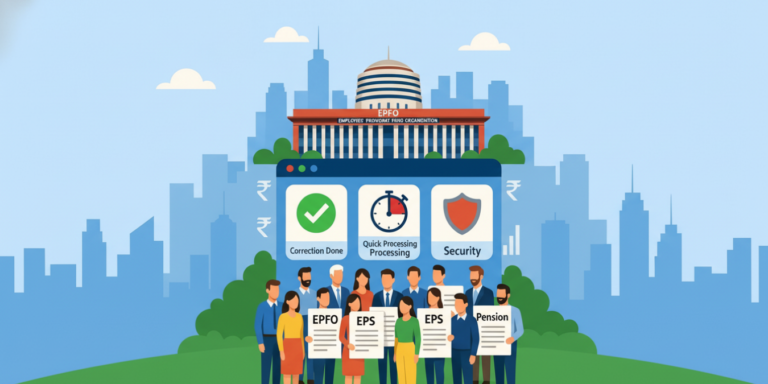
Indian employees face a hidden healthcare crisis: corporate insurance covers only 60% of medical costs, with 39.4% out-of-pocket expenses and Rs 7,500 crore in claim rejections. Soaring 14% medical inflation and policy sub-limits leave families vulnerable. Budget Rs 60,000–1,20,000 yearly and invest in top-up plans to bridge gaps.
India’s healthcare landscape is a paradox of progress and peril. Employer-provided health insurance, while a cornerstone of corporate benefits, leaves Indian employees vulnerable to staggering out-of-pocket expenses due to soaring medical inflation, restrictive policy sub-limits, and frequent claim denials. With medical costs rising at 13–14% annually—one of the highest rates globally—nearly 40% of healthcare expenses still fall on families, even those covered by corporate plans. This blog post unveils the hidden financial gaps in employer health insurance, offers actionable insights to bridge them, and arms you with a strategic budgeting plan to secure your family’s well-being. Prepare for a suspenseful journey through India’s healthcare maze, packed with surprising data, emotional stakes, and practical solutions to ensure you’re never caught off guard.
The Hidden Healthcare Crisis: Why Corporate Insurance Isn’t Enough
Imagine this: You’re an Indian professional, secure in the knowledge that your employer’s group health insurance has you covered. But when a sudden hospitalization strikes, you’re hit with a bill that your policy only partially covers—leaving you to foot a crippling Rs 50,000 out of pocket. This isn’t a rare horror story. In 2025, despite advancements in healthcare access through schemes like Ayushman Bharat, 39.4% of total health expenditure in India remains out-of-pocket (OOPE), down only marginally from 47% in 2019–20. Why? Corporate insurance plans, while valuable, are riddled with gaps that expose employees to financial shocks.
Medical inflation, pegged at 14% in 2025, is outpacing general inflation, driving up costs for hospitalizations, diagnostics, and medications. Corporate plans often impose sub-limits—caps on room rent, ICU charges, or specific treatments—and exclude critical areas like outpatient care, alternative therapies, or pre-existing conditions. Add to this the Rs 7,500 crore in claim rejections reported in 2023, often due to undisclosed exclusions or procedural errors, and it’s clear: relying solely on employer insurance is a risky gamble. The stakes are high—financial ruin, delayed treatments, or even debt traps loom for the unprepared.
Unmasking the Gaps: What Corporate Insurance Misses
Corporate health insurance plans, while a critical perk, are designed for cost efficiency, not comprehensive coverage. Here’s a breakdown of the most common gaps fueling the Rs 7,500 crore claim rejection crisis in 2025:
- Sub-Limits on Key Expenses: Many plans cap room rent at 1–2% of the sum insured (e.g., Rs 5,000–10,000/day for a Rs 5 lakh policy), ICU charges, or specific procedures like cataract surgery or dialysis. Exceeding these limits means out-of-pocket payments.
- Pre-Existing Condition Exclusions: Conditions like diabetes or hypertension often face 1–4-year waiting periods, leading to claim denials if not disclosed or if treatment occurs early in the policy term.
- Non-Covered Treatments: Outpatient care (OPD), fertility treatments, cosmetic procedures, and alternative therapies like Ayurveda or acupuncture are typically excluded.
- Sum Insured Exhaustion: High-cost treatments like organ transplants or cancer care can quickly deplete the sum insured, leaving additional costs uncovered.
- Procedural Denials: Incomplete documentation, delayed claim submissions, or disputes over medical necessity contribute to rejections. In 2023, such errors accounted for a significant portion of the Rs 7,500 crore denied claims.
- Policy Lapses: If premiums aren’t paid on time (e.g., due to employer oversight), claims during lapsed periods are rejected outright.
These gaps highlight why Indian employees must budget extra to cover unexpected costs and protect against claim denials.
Quantifying the Financial Buffer: How Much Extra to Budget?
So, how much should you set aside annually beyond your corporate health insurance? Reports from 2025 estimate that insured Indian families face out-of-pocket expenses of Rs 15,000–30,000 per person annually, depending on family size, health status, and location. For a nuclear family of four, this translates to Rs 60,000–1,20,000 per year. Here’s a breakdown:
- Hospitalization Gaps: Sub-limits on room rent or ICU charges can add Rs 5,000–20,000 per hospitalization event.
- Outpatient Costs: OPD consultations, diagnostics, and medications, often excluded, cost Rs 5,000–15,000 per person yearly.
- Chronic Illness Management: Conditions like diabetes or cancer, partially covered due to waiting periods or sub-limits, can incur Rs 10,000–50,000 annually.
- Claim Rejections: Denied claims for procedural errors or exclusions can lead to sudden expenses of Rs 20,000–1,00,000 per incident.
A practical strategy is to budget an additional 20–30% of your corporate plan’s premium. For a Rs 50,000 annual premium, set aside Rs 10,000–15,000 as a financial buffer. Alternatively, invest in a top-up or super top-up health insurance plan with a sum insured of Rs 10–50 lakh to cover high-cost gaps.
Capital Gains Tax Got You Stressed? Here’s How Unclaimed Interest Can Help
Smart Borrowing in 2025: How RBI’s Latest Lending Rule Unlocks Quick Cash from Your Investments
What Led to DreamFolks Shutting Down Domestic Lounge Services? The Fall of a Lounge Access Giant
Avoiding Tax Traps: The Surprising Ways Clubbing of Income Could Impact Your Finances
Step-by-Step Guide: Verifying Your Corporate Policy’s Limits
To avoid surprises, proactively verify your corporate health insurance policy’s sub-limits and waiting periods. Follow these steps:
- Obtain the Policy Document: Request a detailed group health insurance policy or benefits booklet from your HR department or insurer. This outlines sub-limits, waiting periods, and exclusions.
- Consult HR and Insurer: Schedule a call with your HR benefits manager and the insurer’s customer service to clarify coverage caps (e.g., room rent, surgeries) and waiting periods for pre-existing conditions.
- Cross-Check Master Policy: Access the insurer’s master policy wording online or via the corporate account manager to confirm standardized clauses on limits and exclusions.
- Review Past Claims: Analyze previous claim settlements to identify how sub-limits or waiting periods impacted payouts, offering real-world insights.
- Request a Written Summary: Ask the insurer for a clear, written summary of sub-limits and waiting periods for your records.
- Engage an Insurance Advisor: Consult a professional broker specializing in group health insurance to decode complex policy terms.
By understanding these details, you can plan supplemental coverage or budgeting to bridge gaps effectively.
Ayushman Bharat: A Partial Safety Net
The Ayushman Bharat Pradhan Mantri Jan Arogya Yojana (PM-JAY), launched in 2018, is a game-changer, offering Rs 5 lakh per family annually for secondary and tertiary care to over 12 crore vulnerable families. In 2024, it expanded to cover all citizens aged 70+ regardless of income, benefiting 6 crore seniors. Yet, it’s not a universal fix for employees with corporate insurance. PM-JAY targets the bottom 40% of the population based on SECC-2011 data, leaving many middle-class families ineligible unless they’re seniors.
Even for beneficiaries, PM-JAY has limitations:
- It excludes outpatient care and certain treatments like fertility procedures.
- Its hospital network, while vast, may not include premium private facilities preferred by urban employees.
- Claim denials due to procedural errors or non-covered conditions persist.
While PM-JAY has reduced OOPE from 62.6% in 2014–15 to 39.4% in 2021–22, employees must still budget for gaps not covered by corporate plans or PM-JAY.
Enhancing Protection: The Power of Top-Up Insurance
To bridge corporate insurance gaps, top-up or super top-up health insurance plans are a cost-effective solution. These plans kick in after a deductible (e.g., your corporate plan’s sum insured) is exhausted, offering coverage from Rs 10 lakh to Rs 50 lakh. Key benefits include:
- Affordable Premiums: Top-up plans cost significantly less than standalone policies, with premiums starting at Rs 5,000–15,000 annually.
- Comprehensive Coverage: They cover hospitalization, critical illnesses, and sometimes OPD expenses, addressing corporate plan exclusions.
- Wide Hospital Networks: Many top-up plans include premium private hospitals, ensuring access to quality care.
- Customizable Deductibles: Choose a deductible aligned with your corporate plan’s sum insured for cost efficiency.
For example, Niva Bupa’s Health Premia plan offers a 10% annual sum insured increase and covers pre/post-hospitalization expenses, ideal for young professionals. Pairing a top-up plan with your corporate policy creates a robust safety net.
The Claim Rejection Crisis: Rs 7,500 Crore and Counting
The Rs 7,500 crore in claim rejections in 2023 is a wake-up call. Common reasons include:
- Non-Disclosure of Pre-Existing Conditions: Failing to report conditions like hypertension leads to denials during waiting periods.
- Exclusions for Specific Treatments: Cosmetic surgeries, infertility treatments, and OPD costs are rarely covered.
- Documentation Errors: Incomplete bills or delayed submissions result in rejections.
- Sub-Limit Breaches: Exceeding caps on room rent or procedures triggers partial or full denials.
- Fraud Disputes: Insurers may flag inflated bills or unnecessary hospitalizations.
To avoid rejections, disclose all medical history upfront, maintain meticulous records, and submit claims promptly with complete documentation. A top-up plan can also cover costs denied by corporate policies.
Budgeting Strategies for 2025: A Practical Plan
Here’s a tailored budgeting plan for Indian employees in 2025:
- Assess Your Corporate Plan: Review sub-limits, exclusions, and waiting periods to identify coverage gaps.
- Estimate OOPE: Budget Rs 15,000–30,000 per person (Rs 60,000–1,20,000 for a family of four) for uncovered expenses like OPD, diagnostics, or claim rejections.
- Allocate a Premium Buffer: Set aside 20–30% of your corporate plan’s premium (e.g., Rs 10,000–15,000 for a Rs 50,000 premium) as an emergency fund.
- Invest in Top-Up Insurance: Purchase a Rs 10–50 lakh top-up plan to cover high-cost treatments and exclusions.
- Leverage Tax Benefits: Use Section 80D deductions (up to Rs 25,000) to offset premiums, though the 2025 Budget missed raising this to Rs 50,000.
- Build an Emergency Fund: Save 3–6 months of healthcare expenses in a liquid fund for unexpected denials or lapses.
The Role of Medical Inflation: A Relentless Cost Driver
Medical inflation in India, at 14% in 2025, is a key culprit behind rising healthcare costs. Hospitalization costs rose 12.8% in 2023–24, with average claim sizes jumping from Rs 62,548 to Rs 70,558. Factors driving this include:
- Advanced Treatments: Procedures like angioplasty now cost Rs 2–3 lakh, up from Rs 1–1.5 lakh in 2018.
- Medicine Prices: Prescription drugs rise 5% annually, with specialty drugs for cancer or diabetes being particularly expensive.
- Private Hospital Dominance: With public hospitals overcrowded, private facilities charge premium rates, often uncovered by corporate plans.
This inflation outpaces wage growth, forcing employees to allocate more of their income to healthcare.
Emotional Resonance: The Human Cost of Inadequate Coverage
The financial strain of healthcare gaps isn’t just numbers—it’s deeply personal. Families like Priya’s face agonizing choices: dip into savings, borrow, or delay treatment. The India Fit Report 2025 notes that 43% of Indians fear healthcare costs will derail their financial stability. Delayed treatments worsen conditions, increase mortality, and erode trust in the system. By budgeting proactively and securing top-up coverage, employees can transform anxiety into empowerment, ensuring health emergencies don’t become life-altering crises.
Stunning Suggestions: Building a Robust Healthcare Strategy
To thrive in 2025’s healthcare landscape, adopt these transformative strategies:
- Go Digital: Use apps like Policybazaar to compare top-up plans and buy policies instantly.
- Leverage Employer Benefits: Ask HR about voluntary top-up plans or wellness programs to supplement coverage.
- Engage with PM-JAY: If eligible (e.g., aged 70+), use Ayushman Bharat for secondary/tertiary care, freeing up your budget for OPD costs.
- Preventive Care: Invest in regular check-ups and vaccinations to catch issues early, reducing long-term costs.
- Educate Yourself: Attend HR workshops or consult brokers to understand policy fine print and avoid claim pitfalls.
Summary Table: Suggested Annual Budget Beyond Corporate Health Insurance
| Expense Type | Suggested Annual Budget (INR) |
| Out-of-pocket beyond corporate | Rs 15,000–30,000 per person |
| Annual family budget (4 members) | Rs 60,000–1,20,000 |
| Additional health insurance premium buffer | 20–30% of corporate premium (e.g., Rs 10,000–15,000 for Rs 50,000 premium) |
Final Thought: Mastering Financial Preparedness for Healthcare Security
In 2025, India’s healthcare system is a double-edged sword—offering hope through schemes like Ayushman Bharat but leaving gaps that corporate insurance can’t fill. With medical inflation at 14%, claim rejections costing Rs 7,500 crore, and 39.4% of health expenses still out-of-pocket, Indian employees must act decisively. Budgeting an extra Rs 60,000–1,20,000 annually for a family of four, paired with a Rs 10–50 lakh top-up plan, transforms vulnerability into resilience. This layered approach ensures that health emergencies don’t spiral into financial disasters, safeguarding both your well-being and peace of mind. In a nation where healthcare costs can shatter dreams, proactive planning is your shield—wield it wisely to secure your family’s future.

































